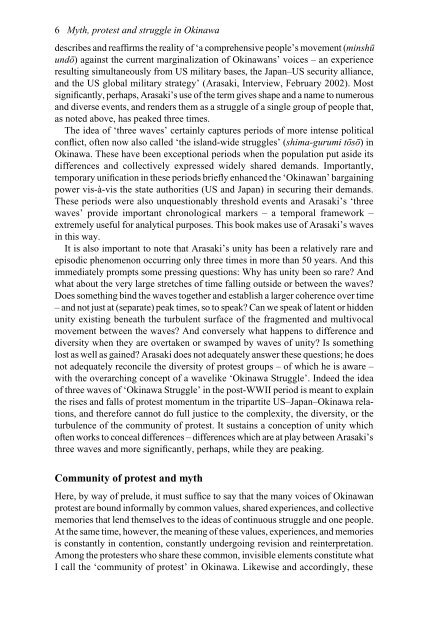Myth, Protest and Struggle in Okinawa
Myth, Protest and Struggle in Okinawa
Myth, Protest and Struggle in Okinawa
Create successful ePaper yourself
Turn your PDF publications into a flip-book with our unique Google optimized e-Paper software.
6 <strong>Myth</strong>, protest <strong>and</strong> struggle <strong>in</strong> Ok<strong>in</strong>awa<br />
describes <strong>and</strong> reaffirms the reality of ‘a comprehensive people’s movement (m<strong>in</strong>shū<br />
undō) aga<strong>in</strong>st the current marg<strong>in</strong>alization of Ok<strong>in</strong>awans’ voices – an experience<br />
result<strong>in</strong>g simultaneously from US military bases, the Japan–US security alliance,<br />
<strong>and</strong> the US global military strategy’ (Arasaki, Interview, February 2002). Most<br />
significantly, perhaps, Arasaki’s use of the term gives shape <strong>and</strong> a name to numerous<br />
<strong>and</strong> diverse events, <strong>and</strong> renders them as a struggle of a s<strong>in</strong>gle group of people that,<br />
as noted above, has peaked three times.<br />
The idea of ‘three waves’ certa<strong>in</strong>ly captures periods of more <strong>in</strong>tense political<br />
conflict, often now also called ‘the isl<strong>and</strong>-wide struggles’ (shima-gurumi tōsō)<strong>in</strong><br />
Ok<strong>in</strong>awa. These have been exceptional periods when the population put aside its<br />
differences <strong>and</strong> collectively expressed widely shared dem<strong>and</strong>s. Importantly,<br />
temporary unification <strong>in</strong> these periods briefly enhanced the ‘Ok<strong>in</strong>awan’ barga<strong>in</strong><strong>in</strong>g<br />
power vis-à-vis the state authorities (US <strong>and</strong> Japan) <strong>in</strong> secur<strong>in</strong>g their dem<strong>and</strong>s.<br />
These periods were also unquestionably threshold events <strong>and</strong> Arasaki’s ‘three<br />
waves’ provide important chronological markers – a temporal framework –<br />
extremely useful for analytical purposes. This book makes use of Arasaki’s waves<br />
<strong>in</strong> this way.<br />
It is also important to note that Arasaki’s unity has been a relatively rare <strong>and</strong><br />
episodic phenomenon occurr<strong>in</strong>g only three times <strong>in</strong> more than 50 years. And this<br />
immediately prompts some press<strong>in</strong>g questions: Why has unity been so rare? And<br />
what about the very large stretches of time fall<strong>in</strong>g outside or between the waves?<br />
Does someth<strong>in</strong>g b<strong>in</strong>d the waves together <strong>and</strong> establish a larger coherence over time<br />
– <strong>and</strong> not just at (separate) peak times, so to speak? Can we speak of latent or hidden<br />
unity exist<strong>in</strong>g beneath the turbulent surface of the fragmented <strong>and</strong> multivocal<br />
movement between the waves? And conversely what happens to difference <strong>and</strong><br />
diversity when they are overtaken or swamped by waves of unity? Is someth<strong>in</strong>g<br />
lost as well as ga<strong>in</strong>ed? Arasaki does not adequately answer these questions; he does<br />
not adequately reconcile the diversity of protest groups – of which he is aware –<br />
with the overarch<strong>in</strong>g concept of a wavelike ‘Ok<strong>in</strong>awa <strong>Struggle</strong>’. Indeed the idea<br />
of three waves of ‘Ok<strong>in</strong>awa <strong>Struggle</strong>’ <strong>in</strong> the post-WWII period is meant to expla<strong>in</strong><br />
the rises <strong>and</strong> falls of protest momentum <strong>in</strong> the tripartite US–Japan–Ok<strong>in</strong>awa relations,<br />
<strong>and</strong> therefore cannot do full justice to the complexity, the diversity, or the<br />
turbulence of the community of protest. It susta<strong>in</strong>s a conception of unity which<br />
often works to conceal differences – differences which are at play between Arasaki’s<br />
three waves <strong>and</strong> more significantly, perhaps, while they are peak<strong>in</strong>g.<br />
Community of protest <strong>and</strong> myth<br />
Here, by way of prelude, it must suffice to say that the many voices of Ok<strong>in</strong>awan<br />
protest are bound <strong>in</strong>formally by common values, shared experiences, <strong>and</strong> collective<br />
memories that lend themselves to the ideas of cont<strong>in</strong>uous struggle <strong>and</strong> one people.<br />
At the same time, however, the mean<strong>in</strong>g of these values, experiences, <strong>and</strong> memories<br />
is constantly <strong>in</strong> contention, constantly undergo<strong>in</strong>g revision <strong>and</strong> re<strong>in</strong>terpretation.<br />
Among the protesters who share these common, <strong>in</strong>visible elements constitute what<br />
I call the ‘community of protest’ <strong>in</strong> Ok<strong>in</strong>awa. Likewise <strong>and</strong> accord<strong>in</strong>gly, these
















